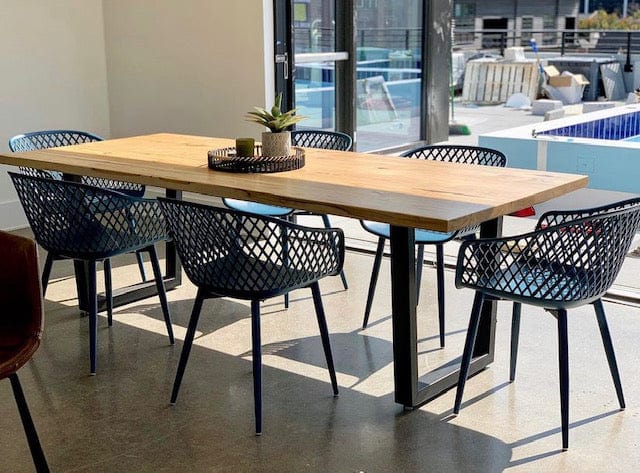Update Your Furnishings with Trendy Dining Room Table Legs
Update Your Furnishings with Trendy Dining Room Table Legs
Blog Article
An In-depth Take A Look At Eating Table Leg Styles: Discovering the Ideal Match
Choosing the right eating table leg design is crucial for both visual appeal and practical performance. Standard 4 legs provide timeless sophistication and security, while the stand base provides enhanced legroom and a contemporary appearance. For those with bigger tables, trestle legs make certain durable support, whereas hairpin legs introduce a mid-century contemporary vibe with their minimal design. The x-shaped legs mix contemporary style with improved security. Each of these alternatives brings distinct advantages, making the option much more than simply an issue of preference. Check out further to find which design completely enhances your dining space and way of living.
Standard Four Legs
Among the different kinds of eating table leg designs, the conventional four-leg layout continues to be an ageless selection for many families. This classic configuration offers an unified mix of performance and looks, making it a seasonal favorite. 4 legs offer well balanced assistance, making sure the table stays steady and efficient in bearing significant weight. This is specifically helpful for houses that often host large celebrations or use their eating table for numerous purposes, such as job or crafting.
From an aesthetic point of view, the traditional four-leg layout can be conveniently adapted to various indoor styles. Whether crafted from timber, metal, or a combination of products, these legs can be intricately sculpted, streamlined and minimalistic, or anything in between. Their versatility enables them to complement both rustic and contemporary settings flawlessly.
Furthermore, the straightforward structure of the four-leg style facilitates ease of activity and placement within a space. Unlike even more facility bases, this design lessens obstructions, supplying sufficient legroom for restaurants. In recap, the conventional four-leg dining table leg style weds sustaining elegance with functional functionality, making it an astute choice for those seeking both form and function in their dining furnishings.
Pedestal Base
Frequently celebrated for its elegant and space-efficient design, the stand base is a prominent option to the traditional four-leg arrangement in eating table leg designs. Without corner legs, restaurants are paid for greater freedom of motion, making it a suitable option for round and oblong tables that advertise even more intimate and comprehensive gatherings.
Moreover, the stand base's central support can manage significant weight, enabling the use of larger tabletops, such as marble or thick wood. This toughness combined with its aesthetic flexibility makes the pedestal base a prominent selection in both standard and contemporary indoor setups. It can effortlessly incorporate with numerous layout styles, from timeless elegance to minimal modernity. Moreover, the central column itself offers a canvas for complex layouts and imaginative expressions, including an aspect of visual interest beneath the useful reference table. In recap, the pedestal base integrates capability snappy, making it a fine-tuned and useful alternative for diverse eating environments.
Trestle Legs
Trestle legs provide a robust and classic foundation for dining tables, characterized by their horizontal cross-bracing and strong support beams. Stemming from middle ages times, this design has advanced yet maintained its crucial framework, making it a seasonal fave in both standard and modern settings. The main trestle beam of light, typically supported by two or more my blog vertical posts, supplies phenomenal security, enabling for larger table sizes without the demand for added legs.
A substantial advantage of trestle leg tables is the adequate legroom they use. Unlike tables with four corner legs, the absence of obstructions at the table's sides gives unimpeded space for chairs and diners, improving convenience and ease of access. This makes trestle tables ideal for fitting bigger celebrations, whether in an eating area or a reception hall.
The aesthetic adaptability of trestle legs is noteworthy. Available in a selection of products such as timber, steel, and composite, they can be completed to match a vast range of interior styles. From rustic farmhouse to sleek modern designs, trestle legs can be personalized to fit specific preferences. Their long-lasting allure and functional advantages make trestle legs an engaging choice for those seeking both style and practicality in their eating table.
Barrette Legs

The allure of barrette legs hinges on their simplicity and adaptability - dining room table legs. Readily available in a variety of products, including steel and brass, they can be completed in numerous colors to match various interior styles. Whether coupled with a rustic wooden table top or a modern glass surface area, barrette legs effortlessly blend performance with a touch of vintage appeal
Sturdiness is one more significant feature of barrette legs. In spite of their fragile look, these legs are engineered to birth considerable weight, ensuring the table remains secure and safe. Additionally, they are relatively easy to install, making them a popular choice for DIY fanatics and specialist furniture manufacturers alike.
X-Shaped Legs

Created from materials such as steel, timber, or a mix of both, X-shaped legs can be tailored to match numerous style choices. Steel legs often lend a streamlined and industrial feel, suitable for loft-style apartment or condos and contemporary dining areas.
Furthermore, the engineering behind X-shaped legs makes sure also weight distribution, lessening the threat of tottering and enhancing toughness. This makes them particularly fit for larger table that call for extra assistance. Essentially, X-shaped legs blend functional engineering with contemporary aesthetics, making them an ageless choice for varied dining environments.
Conclusion
A detailed understanding of dining table leg designs reveals the unique features and benefits of each design. Traditional 4 legs supply stability and classic allure, while pedestal bases give legroom and a streamlined look. Trestle legs make certain durable support for larger tables, and hairpin legs introduce a mid-century contemporary visual. X-shaped legs combine modern layout with boosted security. Selecting the appropriate leg style guarantees both practical and aesthetic contentment in any kind of eating space.
Report this page